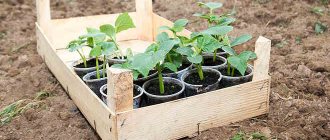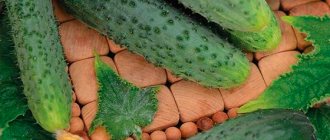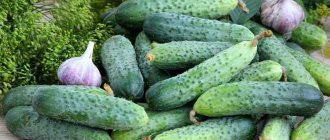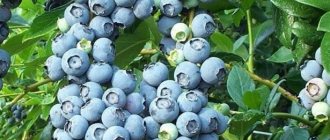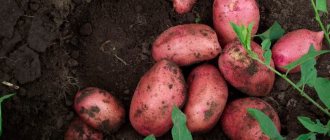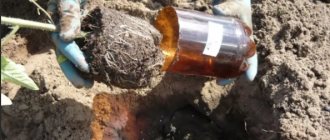When home garden owners think about which variety or hybrid of cucumbers to choose for planting, the choice often falls on the Herman F1 hybrid. This is understandable; this cucumber is considered by many to be the best. Cucumber Herman F1, a description of the variety, reviews with photographs of which are reflected in this article, is distinguished by high yield, early ripening, and the greens do not have bitterness. Pollination is not required for fruit set; caring for the hybrid is quite simple.
Hybrid Herman grows well in greenhouses and in open ground, showing resistance to various diseases. Thanks to its positive qualities, German can be considered one of the best varieties bred in recent years.
Description and characteristics of the hybrid
Herman was bred by specialists from the Dutch company Monsanto. In 2001, the hybrid was included in the State Register and began to be used by summer residents for planting in Russia.
The hybrid is parthenocarpic; it can be grown with equal success in open ground and greenhouse conditions. In terms of ripening time, it is classified as early ripening; 38 days pass from the germination of the crop to the harvesting of the first harvest.
Medium-sized plant, determinate. This means that the bush itself stops growth after a certain number of ovaries are formed. The leaves of the hybrid are colored green and are of medium size.
Seeds obtained from the Herman hybrid do not retain the beneficial qualities of the parent and are therefore not suitable for further propagation. Herman produces only female flowers that do not require pollination. Inflorescences are formed in bunches in each leaf axil. 4-6 flowers are formed in one bunch at the same time.
The flowers produce cucumber ovaries, which look like gherkins. The length of the fruit reaches 10 cm.
Why do German cucumbers sometimes turn yellow?
The color of gherkins depends on the degree of illumination and can be light green or darker tones. Light color is usually observed when plants are very thick, which occurs when:
- lack of bush formation;
- high planting density.
The diameter of the fruit varies between 2.5-3 cm, weight reaches 100 grams. The shape of the greens is smooth, medium-ribbed, cylindrical, moderately tuberculate. There are light spikes on the surface of the fruit.
The pulp of the Hermann variety cucumber is soft, with a light aroma, sweetish in taste, without bitterness. The dark green peel shows slight spotting and short stripes of white. This hybrid is more suitable for making salads.
The hybrid is characterized by high productivity; from 1 m² you can get up to 25 kg of cucumbers. Cucumbers do not turn yellow during storage and can withstand transportation over long distances. The fruits are suitable for preparations; they can be salted and pickled.
Herman shows resistance to diseases:
- powdery mildew;
- olive spot;
- cucumber mosaic.
Diseases and pests of the German variety (table)
| Diseases/pests | Signs of defeat | Methods of control and prevention |
| Diseases | ||
| Rust | Orange spots appeared on the shoots and leaves of the plant. | Treatment of plants with fungicides at an early stage. You can use Fundazol: 10 g per 10 liters of water (2 times per season). Last treatment 10 days before harvest: 1.5 liters per 10 square meters. |
| Downy mildew (downy mildew) | White spots appear on the leaves, which then cover the entire leaf. | |
| Pests | ||
| Aphid | The leaves curl, the flowers wither and fall off. | Treatment of plants with tobacco infusion, wood ash infusion and laundry soap. You can also use an infusion of onion or garlic: finely chop 70–90 g of onion or 40 g of garlic and add 10 liters of water. Spraying is carried out every other day. |
| Spider mite | Green leaves change color and die. | Treating leaves with soapy water. For prevention, the area needs to be dug well. It is also recommended to use an infusion of celandine, dandelion, yarrow, and horse sorrel. |
| Root nematode | Plants slow down and yields are noticeably reduced. | Treat the soil in greenhouses and greenhouses with steam. In open areas, the top layer of soil must be replaced. |
Photo gallery: how to recognize diseases?
Spider mite
Aphids on leaves
Downy mildew (downy mildew)
Rust
Advantages and disadvantages
Like any variety or hybrid, Hermann has disadvantages and advantages. But he has much more advantages than negative qualities.
Among the advantages, the following should be noted:
- ability to self-pollinate;
- early harvest formation;
- high yield;
- long fruiting period;
- suitability for growing in garden beds and in a greenhouse;
- resistance to a number of dangerous diseases;
- cucumbers are very tasty, have no bitterness;
- cucumbers do not turn yellow during storage;
- attractive appearance of the fruit;
- versatility in the use of crops.
Among the shortcomings are the following:
- at the initial stage of growth, the hybrid has a weak root system;
- when planted in cold soil, plants stop growing;
- during the growing season, plants do not tolerate a decrease in air and soil temperatures;
- poor resistance to rust;
- The hybrid does not tolerate heat well.
Reviews of German cucumbers
Mikhail, Ryazan. I planted this variety for two years in a row. In the first year, the bushes formed incorrectly, and the harvest was not very abundant. But last year I paid more attention to cucumbers and was rewarded. I was very pleased with the harvest. Cucumbers appeared earlier than their neighbors. Very tasty and crispy. Enough for salads and pickling. Herman really liked the pickling – the crispy pickled cucumbers turned out very tasty!
Elena, Rostov. I buy seeds of this variety, despite the cost. Dear ones, but everything is sprouting. Cucumbers can be stored for a long time, so you don’t have to worry about them going bad. And if we don’t have time to collect them in time, they don’t outgrow and turn yellow.
Soil requirements
The hybrid grows well on different types of soil, but has an increased requirement for heat. You should provide it with a soil temperature above 14 degrees. Otherwise, the seeds will take a long time to germinate, and cucumber seedlings will take a long time to adapt to unfavorable conditions.
Herman is a high-yielding hybrid, which means that a lot of nutrition is required to form a crop. Hence the increased requirement of the hybrid for soil fertility.
To get a decent harvest, you will need to add the following to each square meter of garden beds:
- a bucket of rotted manure;
- bucket of peat;
- a bucket of sand to make the soil loose;
- 1 tbsp. superphosphate;
- 1 tbsp. potassium nitrate;
- 1 tbsp. ammonium nitrate.
How to sow?
The German cucumber variety is distinguished by its rather powerful bush development and must have enough space for normal growth. It is advisable to maintain the distance between the rows at 60 cm, and the planting spacing in the row is at least 30 cm.
Planting by seeds
German cucumber seeds are covered with a protective shell and do not require additional processing before sowing. The manufacturer guarantees their germination rate at 95% or more, and therefore, when sowing seeds, they are placed one at a time.
When sowing, the following parameters must be maintained:
| Parameter | Distance, cm |
| planting depth | 1,5-2 |
| distance between rows | 70-75 |
| spacing between seeds in a row | 30-35 |
Attention! If sowing was done in an open garden bed, after sowing it is advisable to cover it with a synthetic film. It will raise the temperature a little and retain moisture. With the appearance of single shoots, the shelters are removed from the beds.
Sowing begins when the soil warms up to 12 degrees. The air temperature should be kept at 17 degrees and above. Typically, such temperature indicators occur in Russia in the first ten days of May; there are differences in each region.
Planting seedlings
If the initial goal is to obtain an extremely early harvest, the Herman hybrid is grown through seedlings. Seedlings are planted in open ground at the age of 25-30 days.
Seedlings should grow in containers that allow them to be selected at the time of planting with a ball of earth on the roots. Thanks to this, the roots are less damaged.
Before planting cucumber seedlings German F1, you need to prepare the area:
- dig up the soil;
- make planting holes;
- apply fertilizer.
For planting, use seedlings with 3-4 true leaves. Seedlings are buried in the soil up to the cotyledon leaves.
What is remarkable about the variety?
Herman F1 cucumbers are a variety loved by gardeners for their excellent taste
Summer residents have long loved German F1 cucumbers for a number of positive characteristics, and today they are successfully grown in all regions of the country. The characteristic features of the culture are as follows:
- This is a high-yielding variety, the productivity of which reaches 25 kg per 1 m2.
- The plant is distinguished by early ripening. From the emergence of seedlings to the formation of fruits, 35–40 days pass.
- Cucumbers have powerful stems that grow up to 4–5 m. They are quite resistant to external influences and do not break as a result of bending.
- Female flowering type. The variety is determinate, that is, the growth of the main shoot is limited.
- The leaves are medium in size and have a rich dark green color. 6–7 ovaries are formed in one node.
- The fruits are cylindrical, ribbed, grow up to 10 cm in length. Their weight ranges from 70 to 90 g. The skin is dark green in color with light stripes, covered with a faint waxy coating and pubescence. White thorns can be seen on cucumbers.
- The pulp is aromatic with a characteristic crunch and medium-dense structure, has a sweetish taste without bitterness . According to the tasting scale, the fruits of this variety received the highest rating - 5 points out of 5.
Important! During storage, cucumbers do not turn yellow.
Care after landing
Herman, judging by the reviews of gardeners, it is not enough to plant correctly. Post-planting care of the crop is of great importance.
To get a decent harvest, you need to do the following:
- water every 3 days;
- fertilize approximately three times per season;
- during the growing season, fight weeds;
- loosen the soil after each watering;
- As the plants grow, tie them to the trellis;
- carry out the formation of bushes;
- Collect greens in a timely manner, preventing them from overgrowing.
The formation of cucumber bushes is carried out according to the following rules:
- remove all shoots and flowers from 1 to 4 leaf axils;
- in the axils of the 5th and 6th leaves, remove the sprout and leave 1 ovary;
- in the axils of 7-10 leaves, remove the sprout and leave 2 ovaries;
- when the stem outgrows the trellis, you need to throw it over it;
- pinch the growth point of the cascading stem when the distance to the ground is 1 meter.
Important! You should not water cucumbers with cold water, as this will cause the fruits to taste bitter and the development of plants will stop. When the air temperature drops to +12 degrees or lower, you need to reduce the rate and number of waterings.
Features of cultivation
Herman f1 is valued by gardeners, among other things, for its ease of care. Even a novice vegetable grower can grow such a cucumber. The main thing is to regularly water the beds and periodically feed the variety with nutritious mineral mixtures, not forgetting about weeding. Hill up the cucumber every 10 days, sprinkling the bushes just above 1/3 of their height.
Form a Herman f1 bush from the main stem, tying it to a trellis. To strengthen the vulnerable root system, the cucumber is blinded above the 4th leaf. At levels 5-6, 1 ovary is left, then up to level 10 - two. The crown of the variety plant is pinched when it grows to the top of the trellis.
Watering
The described variety is sensitive to compliance with watering rules. This cucumber is irrigated every 2-3 days, late in the evening, at the same time. Watering should be continuous and moderately warm – 24°-25°C. It is best to use soft, pre-purified liquid without chlorine under German f1.
Irrigation is carried out using the drip method, exactly under the roots of the variety. Droplets of liquid should not fall on the leaves of Herman f1 - they can cause burns to delicate tissue.
In a dry spring, the frequency of irrigation is increased to daily - so that the cucumber does not dry out. Every second watering is accompanied by loosening - the roots of Herman f1 should not remain in the “swamp” - otherwise the cucumber will quickly begin to rot.
Top dressing
For normal development and maximum development of taste, Herman f1 needs nutritious fertilizers - mineral and organic. The former are used in moderation so as not to cause burns and damage to the roots. Fertilizers are applied to the cucumber three times, according to the scheme described below:
- For the first time, the sprouts of the variety are fertilized on the 3rd day after transplantation - with nitroammiaphosphate, or superphosphate;
- the next feeding of German f1 plantings is timed to coincide with the beginning of flowering - use a solution of urea or bird droppings;
- finally, the cucumber receives the third fertilizer at the end of the formation of the ovaries - wood ash or potassium salt is added to the beds.
To increase the yield, it is permissible to grow the variety under mulch of rotted sawdust or onion peels. Fertilizing is combined with irrigation, maintaining an interval of 10-14 days.
How to get an additional harvest wave?
With the right technology, you can get an additional harvest of Herman cucumber. In August, the growth of green plants on the bush decreases, but by applying appropriate foliar feeding, you can get a new wave of fruiting.
Below are 2 popular feeding recipes:
- Milk with iodine. Take 9 liters of warm water, add 1 liter of milk, 35 drops of iodine. After mixing, the solution is ready for use.
- Boric acid. Dissolve 10 g of the product in 1 liter of very hot water. Then add cold water, bringing the volume to 10 liters.
Important! To extend fruiting time, it is recommended to hill up cucumber bushes so that additional roots can grow. It is important to remove yellow leaves.
Sowing seeds, planting seedlings
In most cases, cucumber seeds from domestic producers are sold. If you manage to buy real Dutch seeds, you will not need to prepare them for sowing; they have already been processed accordingly, as evidenced by their color.
Untreated seeds are disinfected for half an hour in a 1% solution of potassium permanganate. Next, they are washed and wrapped in a piece of cotton cloth and placed in a warm place. After a few days, the seeds will sprout.
The recommended soil temperature when planting is + 14 +15 C. Considering that the Herman cucumber does not like either low or too high temperatures, you should choose a place that, if necessary, can be shaded or sheltered from the cold.
When using the seedling method of cultivation, it is recommended to use peat pots and plant seedlings in the ground with them. This option allows you to transplant plants with minimal trauma to the roots. The seedlings will take root easier.
You can increase plant productivity by using the double transshipment method. The seeds are first sown in containers 6-7 cm high, keeping a distance of 3-4 cm between plants. To maintain high humidity, the containers are kept under a film cover. At a temperature of +22 +24 C, which is considered optimal. It will take approximately 6 days for seedlings to emerge in closed ground.
After two true leaves appear on the seedlings, they are picked, i.e. transplanted into individual pots, while the stem is immersed in the soil to the level of the cotyledons; the submerged surface will over time acquire additional roots.
After 3-5 true leaves appear, the seedlings are planted in the ground.
Recommended planting pattern for the German F1 variety: 30-40 cm between bushes, row spacing - at least 50 cm.
When sowing seeds in open beds, you must remember that it will be much more difficult to protect the plantings from spring frosts; there is also a threat that fragile plants will get sick more often; the harvest, in any case, will be obtained later.
How to harvest and store crops?
To prevent greens from overgrowing, they should be collected 3 times a week. With this approach, fruiting will be long and abundant.
For pickling, pickle cucumbers 5-7 cm long are collected. If you plan to use cucumbers for salads or pickling, pickle greens 10 cm long are collected. The fruits can be stored for no more than a week. During this time they will not turn yellow and will remain marketable. Cleaning is carried out in the morning or evening hours.
Having carefully read the description and characteristics of parthenocarpic Herman cucumbers, we can conclude that the hybrid is a good choice for gardeners. With the right technology, the manufacturer guarantees a high and stable harvest. German is not as often affected by dangerous diseases as other varieties. A large list of useful properties and qualities allows us to hope for a decent harvest of tasty fruits.
Harvesting
Herman actively bears fruit throughout the summer, right up to the first autumn frosts. It is recommended to collect fruits once every 2 days, cutting them off with scissors (to prevent stump rotting).
Parthenocarpics do not grow too large, but if not picked in time, they can inhibit the appearance of new cucumbers. The fresh shelf life is 7 days. Cucumbers should be stored in a cool place. The variety is perfect for pickles and marinades.
In less than 20 years of cultivation, Herman F1 has captivated gardeners around the world with its early ripening, excellent presentation, abundant fruiting and taste. It does not require complex care and does not bother owners with too frequent illnesses.
By following the simple rules discussed in the article, you can get an excellent harvest and enjoy the juicy taste of fresh, aromatic cucumbers or pickle them for the winter.
